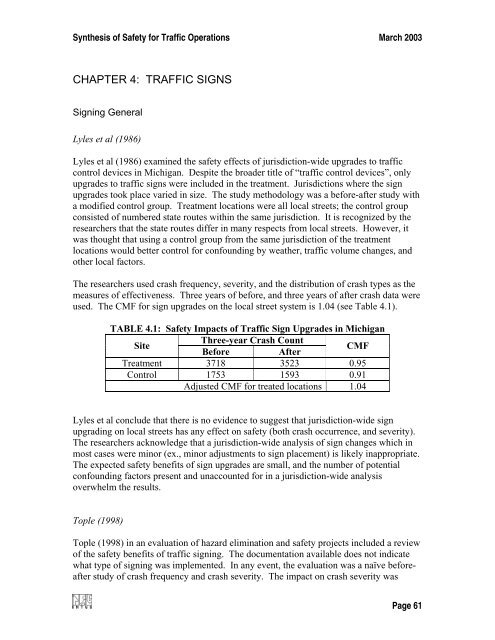Synthesis of Safety for Traffic Operations - Transports Canada
Synthesis of Safety for Traffic Operations - Transports Canada
Synthesis of Safety for Traffic Operations - Transports Canada
You also want an ePaper? Increase the reach of your titles
YUMPU automatically turns print PDFs into web optimized ePapers that Google loves.
<strong>Synthesis</strong> <strong>of</strong> <strong>Safety</strong> <strong>for</strong> <strong>Traffic</strong> <strong>Operations</strong> March 2003<br />
CHAPTER 4: TRAFFIC SIGNS<br />
Signing General<br />
Lyles et al (1986)<br />
Lyles et al (1986) examined the safety effects <strong>of</strong> jurisdiction-wide upgrades to traffic<br />
control devices in Michigan. Despite the broader title <strong>of</strong> “traffic control devices”, only<br />
upgrades to traffic signs were included in the treatment. Jurisdictions where the sign<br />
upgrades took place varied in size. The study methodology was a be<strong>for</strong>e-after study with<br />
a modified control group. Treatment locations were all local streets; the control group<br />
consisted <strong>of</strong> numbered state routes within the same jurisdiction. It is recognized by the<br />
researchers that the state routes differ in many respects from local streets. However, it<br />
was thought that using a control group from the same jurisdiction <strong>of</strong> the treatment<br />
locations would better control <strong>for</strong> confounding by weather, traffic volume changes, and<br />
other local factors.<br />
The researchers used crash frequency, severity, and the distribution <strong>of</strong> crash types as the<br />
measures <strong>of</strong> effectiveness. Three years <strong>of</strong> be<strong>for</strong>e, and three years <strong>of</strong> after crash data were<br />
used. The CMF <strong>for</strong> sign upgrades on the local street system is 1.04 (see Table 4.1).<br />
TABLE 4.1: <strong>Safety</strong> Impacts <strong>of</strong> <strong>Traffic</strong> Sign Upgrades in Michigan<br />
Site<br />
Three-year Crash Count<br />
Be<strong>for</strong>e<br />
After<br />
CMF<br />
Treatment 3718 3523 0.95<br />
Control 1753 1593 0.91<br />
Adjusted CMF <strong>for</strong> treated locations 1.04<br />
Lyles et al conclude that there is no evidence to suggest that jurisdiction-wide sign<br />
upgrading on local streets has any effect on safety (both crash occurrence, and severity).<br />
The researchers acknowledge that a jurisdiction-wide analysis <strong>of</strong> sign changes which in<br />
most cases were minor (ex., minor adjustments to sign placement) is likely inappropriate.<br />
The expected safety benefits <strong>of</strong> sign upgrades are small, and the number <strong>of</strong> potential<br />
confounding factors present and unaccounted <strong>for</strong> in a jurisdiction-wide analysis<br />
overwhelm the results.<br />
Tople (1998)<br />
Tople (1998) in an evaluation <strong>of</strong> hazard elimination and safety projects included a review<br />
<strong>of</strong> the safety benefits <strong>of</strong> traffic signing. The documentation available does not indicate<br />
what type <strong>of</strong> signing was implemented. In any event, the evaluation was a naïve be<strong>for</strong>eafter<br />
study <strong>of</strong> crash frequency and crash severity. The impact on crash severity was<br />
Page 61
















